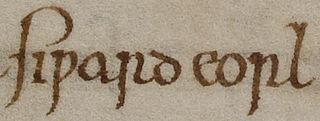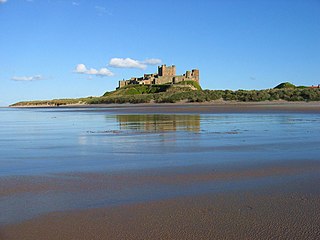
Donald III was King of Scots from 1093 to 1094 and 1094–1097. He was known as Domnall Bán or "Donald the Fair", anglicized as Donalbain.

Máel Coluim mac Cináeda was King of Alba (Scotland) from 1005 until his death in the year 1034. He was one of the longest-reigning Scottish kings of that period.
Waltheof, Earl of Northumbria was the last of the Anglo-Saxon earls and the only English aristocrat to be executed during the reign of William I.
Crínán of Dunkeld, also called Crinan the Thane, was the hereditary abbot of the monastery of Dunkeld, and perhaps the Mormaer of Atholl. Crínán was progenitor of the House of Dunkeld, the dynasty which would rule the Kingdom of Scotland until the later 13th century. He was the son-in-law of one king, and the father of another.

Siward or Sigurd was an important earl of 11th-century northern England. The Old Norse nickname Digri and its Latin translation Grossus are given to him by near-contemporary texts. It is possible Siward may have been of Scandinavian or Anglo-Scandinavian origin, perhaps a relative of Earl Ulf, although this is speculative. He emerged as a regional strongman in England during the reign of Cnut. Cnut was a Scandinavian ruler who conquered most of England in the 1010s, and Siward was one of many Scandinavians who came to England in the aftermath, rising to become sub-ruler of most of northern England. From 1033 at the latest, he was in control of southern Northumbria, present-day Yorkshire, governing as earl on Cnut's behalf.

Alhred or Alchred was king of Northumbria from 765 to 774. He had married Osgifu, either the daughter of Oswulf, granddaughter of Eadberht Eating, or Eadberht's daughter, and was thus related by marriage to Ecgbert, Archbishop of York. A genealogy survives which makes Alhred a descendant of Ida of Bernicia through a son named Eadric.
Osulf or Oswulf was the son of Eadwulf IV, Earl of Bamburgh, and grandson of Uhtred the Bold, ruler of Bamburgh and ealdorman of Northumbria. Oswulf’s family ruled Bamburgh from 954 until 1041, though their independence may have been compromised after 1041 when Siward the Stout killed Eadwulf and gained hegemony over the north.
Uhtred of Bamburgh, was ruler of Bamburgh and from 1006 to 1016 the ealdorman of Northumbria. He was the son of Waltheof I, ruler of Bamburgh (Bebbanburg), whose family the Eadwulfings had ruled the surrounding region for over a century. Uhtred's death by assassination was described in De obsessione Dunelmi and has been interpreted as the beginning of a blood feud. Not to be confused with Uhtred the son of Eadwulf I of Bamburgh, which is why he historically has been referred to as Uhtred the Bold.

Oswulf was ruler of Bamburgh and subsequently, according to later tradition, commander of all Northumbria under the lordship of King Eadred of England. He is sometimes called "earl" or "high reeve", though the precise title of the rulers of Bamburgh is unclear. By the twelfth century Oswulf was held responsible for the death of Northumbria's last Norse king, Eric of York, subsequently administering the Kingdom of York on behalf of Eadred.
Waltheof was high-reeve or ealdorman of Bamburgh. He was the son of Ealdred, and the grandson of Oswulf I and was father of Uhtred the Bold, Ealdorman of Northumbria. His name is Scandinavian which may imply that he had Viking ancestors.
Gospatric II was Earl of Lothian or Earl of Dunbar in the early 12th century.
Gospatric III or Cospatric III was a twelfth-century Anglo-Celtic noble, who was Earl of Lothian and later the Earl of Dunbar, and feudal Lord of Beanley.
Events from the 1060s in England.
De obsessione Dunelmi is an historical work written in the north of England during the Anglo-Norman period, almost certainly at Durham, and probably in either the late 11th or early 12th century.
Eadulf or Eadwulf Rus was an 11th-century Northumbrian noble. He was either the son or grandson of Gospatric, possibly the man who soon after Christmas 1064 was allegedly killed on behalf of Tostig, Earl of Northumbria. This murder by Tostig led to a great northern revolt against Edward the Confessor, a revolt that turned both King Edward and Harold Godwinson against Tostig and led to the appointment of the Mercian, Morcar, as Earl of northern England.
Osbeorn, also spelled Osbjorn and Osbert, given the nickname Bulax, was the son of Siward, Earl of Northumbria. He is one of two known sons of Siward, believed to be the elder. While it is normally assumed he was the son of Siward's Bamburgh wife Ælfflæd, it has been suggested by William Kapelle that Osbeorn's mother was not Ælfflæd. The nickname "Bulax" probably represents the Old Norse term for "Poleaxe".
Thurbrand, nicknamed "the Hold", was a Northumbrian magnate in the early 11th century. Perhaps based in Holderness and East Yorkshire, Thurbrand was recorded as the killer of Uhtred the Bold, Earl of Northumbria. The killing appears to have been part of the war between Sweyn Forkbeard and Cnut the Great against the English king Æthelred the Unready, Uhtred being the latter's chief Northumbrian supporter. Thurbrand may also have attested a charter of 1009 and given a horse to Æthelred's son Æthelstan Ætheling. The killing is the first-known act, if it did not initiate, a bloodfeud between Thurbrand's family and Uhtred going into the time of Earl Waltheof. It is possible that Holderness took its name because of Thurbrand's presence or ownership of the peninsula.
Dolfin was an 11th-century magnate in Cumbria. His father was probably Gospatric, one of the most powerful regional figures in the mid-11th century having been earl of Northumbria in the early years of William the Conqueror's reign. Dolfin was the eldest of Gospatric's three sons, his younger brothers being Waltheof, lord of Allerdale, and Gospatric II, Earl of Lothian.
Waltheof of Allerdale was an 11th- and 12th-century Anglo-Saxon noble, lord of Allerdale in modern Cumbria. Brother of Dolfin of Carlisle and Gospatric of Dunbar, Waltheof was son of Gospatric, Earl of Northumbria. Both Waltheof and his brother Gospatric witness Earl David's Glasgow Inquest 1113 x 1124, and Waltheof also attests some of David's charters as king of the Scots later. The account of Waltheof and his family in Cumbrian monastic cartularies, says that he gave land in Allerdale to his three sisters, Octreda, Gunhilda and Maud.




